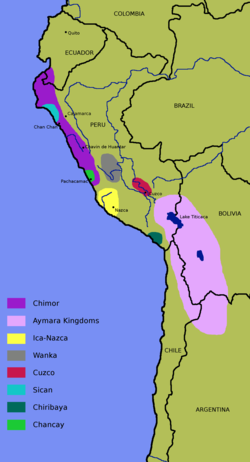
This article includes a list of references, related reading, or external links, but its sources remain unclear because it lacks inline citations .(July 2016) |
This is a chart of cultural periods of Peru and the Andean Region developed by John Rowe and Edward Lanning and used by some archaeologists studying the area. An alternative dating system was developed by Luis Lumbreras and provides different dates for some archaeological finds.
Most of the cultures of the Late Horizon and some of the cultures of the Late Intermediate joined the Inca Empire by 1493, but the period ends in 1532 because that marks the fall of the Inca Empire after the Spanish conquest. Most of the cut-off years mark either an end of a severe drought or the beginning of one. These marked a shift of the most productive farming to or from the mountains and tended to mark the end of one culture and the rise of another.
The more recent findings concerning the Norte Chico civilization are not included on this list, as it was compiled before the site at Caral was investigated in detail.

